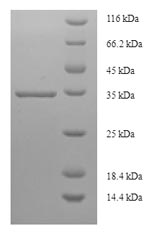The expression region of this recombinant Human PTGDS covers amino acids 23-190. The calculated molecular weight for this PTGDS protein is 34.7 kDa. Expression of this PTGDS protein is conducted in e.coli. The PTGDS coding gene included the N-terminal 6xHis-SUMO tag, which simplifies the detection and purification processes of the recombinant PTGDS protein in following stages of expression and purification.
Prostaglandin-H2 D-isomerase (PTGDS) is an enzyme involved in the biosynthesis of prostaglandin D2 (PGD2). PTGDS belongs to the lipocalin protein family and is primarily expressed in the central nervous system, particularly in the brain and cerebrospinal fluid. The main function of PTGDS is the isomerization of PGH2 to PGD2, which plays a role in various physiological processes, including inflammation and sleep regulation. PGD2 is associated with sleep-wake cycles, and PTGDS has been implicated in sleep-related functions. Additionally, PTGDS has been studied in the context of neuroinflammation, and neurodegenerative diseases, and as a potential biomarker for certain neurological conditions. Understanding the role of PTGDS in prostaglandin metabolism and its broader implications in neurological processes is essential for unraveling its potential therapeutic applications and furthering knowledge of neurobiology.




